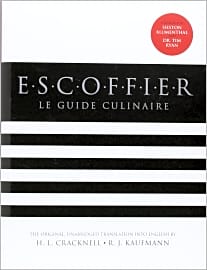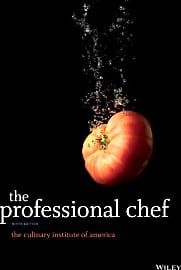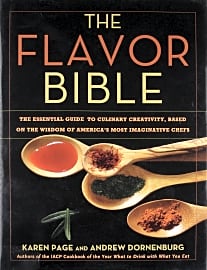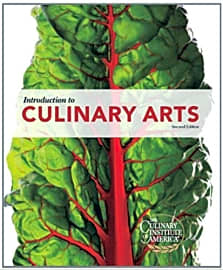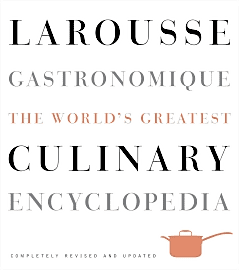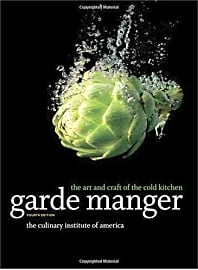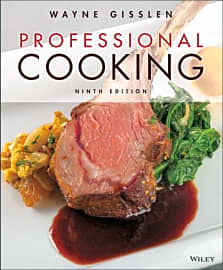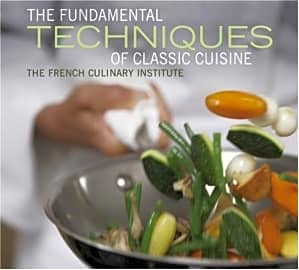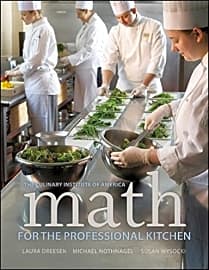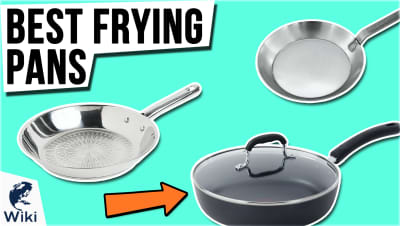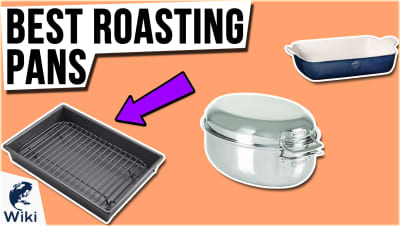The 10 Best Culinary Textbooks


This wiki has been updated 35 times since it was first published in May of 2016. Although these textbooks are not written for casual home cooks, anyone curious about the culinary arts will find them full of interesting and useful information. For those who are planning on a career in the field, however, one or more of these will be essential reading in order to prepare you for the financial, logistical, and creative realities of being a professional in the industry. When users buy our independently chosen editorial selections, we may earn commissions to help fund the Wiki.
Editor's Notes
July 31, 2020:
Not much has changed in the world of cooking in the last year, and many of the same books are still prominent, especially classics like On Food and Cooking and Escoffier: Le Guide Culinaire that will remain in the limelight for generations. Of course, it should be noted that not every single word of these old and beloved tomes is 100% accurate; even in these must-read volumes, there are some procedures that are based more on tradition than actual, observable science. Nonetheless, that doesn't in any way diminish how important and helpful they are.
One addition we did make to the list is the CIA's Garde Manger. Typically, garde manger (literally translated as "the guard of the pantry") is an entry-level position, but it's actually a job that requires significant skill and understanding. This book will help you obtain the understanding, then it's up to you to practice the skill. The Professional Chef is another CIA release that's good for official students as well as those just learning at home.
Reference books like The Flavor Bible and Larousse Gastronomique are useful for spot reading when you need some general inspiration or when you're looking for a specific ingredient to accompany a certain dish. We also want to bring attention to the handful of online cooking courses that we listed in the Special Honors section. These programs vary from casual to impressively in-depth and offer better instruction in things like knife skills than still images and text possibly could.
March 05, 2019:
Nothing can teach you how to cook aside from actually getting in the kitchen and doing it, but the right literature goes a long, long way in providing the background to successful work and play in the culinary arts. For long before any other titles on our list were published, McGee's "On Food and Cooking" and Escoffier's seminal "Le Guide Culinaire" are looked up to as essentially the inarguable and holy truth when it comes to making food. If you are on your way to a decent culinary school, there is an exactly 100% chance that these two volumes have been suggested, and are, in fact, most likely required for you to possess.
Next up is nearly anything by the Culinary Institute of America, or the CIA (not to be confused with the Food and Beverage Institute, or FBI), who are responsible for producing many Michelin star recipients, as well as celebrity chefs, over the decades they've been in business. The Flavor Bible is one that may not be mandated at cooking college, but you'll nonetheless see perched above the desk of many chefs de cuisine. This title, in particular, can help budding creators to understand the vast links between various, unique flavors, enabling them to craft their own, one-of-a-kind edible experiences.
Books such as Fundamental Techniques, Gisslen's Professional Cooking, and Introduction to Culinary Arts help to lay the framework for beginners, and if you're scheduled for a boot-camp-style crash course to help jump-start a new career, there's a good chance you'll run into one of them. Larousse Gastronomique has been praised by such leading chefs as Julia Child herself, while Math for the Professional Kitchen is a solid resource for getting the business and measurement sides of things under your belt.
Special Honors
The Kitchn Instead of the minutiae and hard-to-navigate details of school-oriented books, this helpful digital course is aimed at people who want to learn to cook simply and well. Each lesson covers a single, important topic that nearly any budding chef will appreciate understanding. thekitchn.com
America's Test Kitchen Online From the same chefs and researchers behind the wildly popular TV shows and publications, these online cooking classes take a refreshing, evidence-based approach to an age-old craft that's often plagued by old wives' tales and apocryphal traditions. onlinecookingschool.com
Rouxbe One definite issue with traditional books is that cooking is a dynamic process that relies very much on movement, sounds, smells, and other observations that words and pictures on paper can't completely explain. Rouxbe is one of the most in-depth online schools, and features hundreds of videos that can prove enlightening to both casual and professional cooks and chefs. rouxbe.com
Further Than Food
If you want to run a successful kitchen, you’ll have to be.
If you're about to embark on the path to professional chefdom, it's likely because you have a profound love of food. What could be better than getting paid to work with fine ingredients, create innovative menus, and wow others with your dishes? The truth is, there's a lot more to it than just learning fancy techniques, and that’s where a well-balanced culinary textbook comes into play.
When selecting a text, you need to look for one that helps you fill in any gaps in your skill set. For instance, are you good with numbers? If you want to run a successful kitchen, you’ll have to be. You'll be setting menu prices, costing ingredients, converting units of measure, taking inventory, scheduling employee shifts, and paying bills. Familiarity with numbers is vital to running a profitable operation, so look for a text that focuses on the mathematical side of things if you need a refresher.
How good are your organizational skills? In a busy kitchen, efficiency is key, and you must have everything streamlined at all times. If you struggle with keeping things orderly, then a text that devotes a unit to production planning will serve you well. Look for a volume that explains where different types of food should go, how and when to prep, and the best storage techniques. Keeping everything in its right place will help you maintain clean workstations, which is crucial for following food safety laws.
Speaking of safety, did you know that there are specific temperatures that certain foods must be kept at at all times? Or that injuries can easily happen due to a slippery floor or malfunctioning equipment? Thankfully, professional chefs have systems in place to maintain a safe workplace and ensure that food is properly handled. Choose a book that will enlighten you on the best safety practices so that your employees, coworkers, and customers stay healthy and happy.
Any quality culinary textbook will dedicate hundreds of pages to identifying ingredients, proper cooking methods, building flavor, and food science. The trick is to find a comprehensive tome that touches on the lesser-known aspects of the kitchen as well so that when you show up to work, you’ll be fully prepared.
What Types Of Topics Does A Culinary Textbook Cover?
A professional chef has to have an almost encyclopedic knowledge of food in all its forms. That means knowing about everything from broiling and braising to how to properly fold batter or apply egg wash to pastry. It may seem intimidating at first, but thankfully, a culinary textbook will cover the fundamentals you need to get going.
The majority of texts are helpfully broken down into segments based on food type, which allows you to tackle the various ways of preparing each one in a focused manner.
The majority of texts are helpfully broken down into segments based on food type, which allows you to tackle the various ways of preparing each one in a focused manner. Often, they’ll begin with stocks and soups. You’ll learn how to prepare them, thicken them, use leftovers and scraps to your advantage, and blanch bones. These are usually followed by sauces, where you’ll almost certainly learn about thickening agents, reduction techniques, and emulsification.
Then, there’s meat, poultry, and seafood. This is where you’ll read all about sautéing, roasting, baking, steaming, grilling, and smoking. Temperature, seasoning, and basting will be covered, as well as why you use a special kind of pan for frying and another one for roasting. You can expect specifics on what to do with different cuts of beef, how to dress a chicken, and the proper way to poach fish.
You’ll take a deep dive into vegetables, oftentimes focusing particularly on how to handle and prepare potatoes. Legumes, grains, pasta, and other starches come next, and many volumes will touch on dairy and baking after that.
It sounds like a lot, but rest assured that every textbook will have a method of organization to make things streamlined and comprehensible. You'll get a thorough grounding in all the basics you’ll need to know, plus much, much more.
Bon Appétit: A Focus On France
The French are known for many things — laissez-faire parenting, incessant cigarette smoking, and not-so-nice waiters — but when the conversation turns to their culture, it invariably comes back to their impressive cuisine and sophisticated cooking techniques. You might wonder, why does France always dominate discussions about fine dining when there are so many other delicious food cultures around the world?
France's glowing reputation started to take form hundreds of years ago. During the Middle Ages, cooks presented meals as service en confusion, which meant that they served every dish simultaneously and diners ate family-style with their hands. Visual display was important, with chefs using bright colors and gold and silver leaf to create showy dishes.
Escoffier used refined techniques and introduced the brigade system that many professional kitchens still use today.
By the time of the Ancien Régime, Paris was the hub of culture and economic activity, and as such, many skilled culinary craftsmen lived there. The city government created special guilds, with each dedicated to one profession in the culinary industry. This gave rise to butchers, bakers, pastry cooks, sauce makers, and more, who honed their expertise and techniques within these groups.
In the 1500s, an influential Florentine princess named Catherine de' Medici arrived to marry the future king of France, and she brought along Italian cookbooks and customs. While the French had already been making presentation a priority, after Catherine's arrival, food became theater.
After the French Revolution brought about the expulsion of much of the ruling class, cooks and servants were able to open restaurants and use their skills to feed the masses. The 1800s saw the rise of Georges Auguste Escoffier and haute cuisine, which had a profound impact on Americans and other Europeans. Escoffier used refined techniques and introduced the brigade system that many professional kitchens still use today. Then came nouvelle cuisine, in which chefs rebelled against the complicated methods of Escoffier, and instead focused on lightness and clarity of flavor. These days, French cuisine strikes a balance between haute and nouvelle.
Thanks to an obsession with fresh ingredients and immaculate presentation, along with a reverence for food and deep knowledge of it, France has become synonymous with quality dining around the world. They've pushed boundaries, invented and popularized techniques, and given us dishes like coq au vin, quiche, French onion soup, and the cheese soufflé, among many others.


